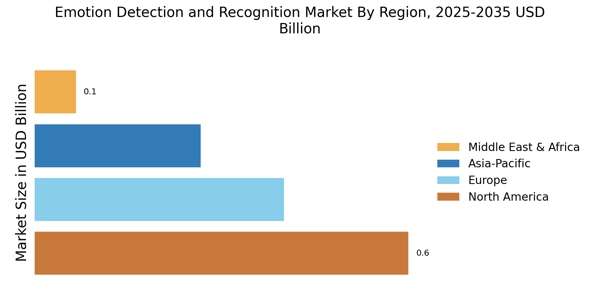Increased Adoption in Healthcare
The Emotion Detection and Recognition Market is experiencing increased adoption within the healthcare sector. Healthcare providers are leveraging emotion recognition technologies to monitor patient emotions, which can be crucial for mental health assessments and treatment plans. The ability to detect emotional states can lead to more personalized care and improved patient outcomes. Recent studies suggest that emotion detection tools can enhance therapeutic interventions, making them more effective. As mental health awareness continues to rise, the demand for these technologies in healthcare settings is likely to expand, contributing to the overall growth of the emotion detection market.
Integration in Marketing Strategies
The Emotion Detection and Recognition Market is becoming an integral part of modern marketing strategies. Marketers are increasingly utilizing emotion recognition technologies to gauge consumer reactions to advertisements and products. By analyzing emotional responses, companies can refine their marketing campaigns to resonate more effectively with target audiences. This trend is particularly pronounced in digital marketing, where real-time feedback can inform content creation and delivery. As businesses strive to create more engaging and impactful marketing experiences, the incorporation of emotion detection tools is expected to grow, potentially leading to a market expansion valued at billions in the near future.
Advancements in AI and Machine Learning
The Emotion Detection and Recognition Market is significantly influenced by advancements in artificial intelligence and machine learning technologies. These innovations enable more accurate and efficient emotion recognition through facial expressions, voice intonations, and physiological signals. As AI algorithms become more sophisticated, the ability to analyze and interpret human emotions in real-time is improving. This is particularly relevant in sectors such as healthcare, where emotion detection can enhance patient care and outcomes. The integration of AI in emotion recognition systems is expected to drive market growth, with projections indicating a potential market size exceeding several billion dollars by the end of the decade.
Growing Focus on Mental Health Solutions
The Emotion Detection and Recognition Market is seeing a growing focus on mental health solutions. As awareness of mental health issues increases, there is a corresponding demand for technologies that can assist in identifying emotional distress. Emotion detection tools are being integrated into various applications, from therapy apps to workplace wellness programs, to provide insights into emotional well-being. This trend is likely to drive innovation and investment in the market, as stakeholders seek to develop solutions that address mental health challenges. The potential for these technologies to improve mental health outcomes positions the emotion detection market for substantial growth in the coming years.
Rising Demand for Enhanced Customer Experience
The Emotion Detection and Recognition Market is witnessing a surge in demand for technologies that enhance customer experience. Companies are increasingly recognizing the value of understanding consumer emotions to tailor their services and products. This trend is particularly evident in sectors such as retail and hospitality, where emotional insights can lead to improved customer satisfaction and loyalty. According to recent estimates, the market for emotion detection technologies is projected to grow at a compound annual growth rate of over 20% in the coming years. This growth is driven by the need for businesses to differentiate themselves in a competitive landscape, making emotional intelligence a key component of customer engagement strategies.

















Leave a Comment